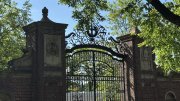Among the most important gains intended from the governance reforms unveiled in late 2010 is enhanced capacity for the Harvard Corporation to think strategically: to envision the institution’s chief challenges and opportunities, and to help its leaders navigate toward future strengths. In the years since, the imperative of mounting The Harvard Campaign successfully has been, de facto, a proxy for strategy—at least in the near term: shore up financial aid, pursue deferred building projects at several schools, invest in engineering and applied sciences particularly.
But occasional briefings by the Corporation’s senior fellow have provided encouraging hints that the hard work of peering beyond the immediate fundraising horizon is under way, too. During the most recent such conversation, William F. Lee identified six strategic priorities, ranging from the financial and practical (Harvard Management Company and the endowment; Allston development) to the programmatic (life sciences; “One Harvard” initiatives) to the broadly intellectual and cultural (campus life, diversity, and inclusion; the place of humanities and social sciences in the liberal arts). All to the good—and alumni, faculty and staff members, and students look forward to their evolution and expression.
To that end, it may be helpful to point to similar efforts and differing practices at some peer institutions. As reported, Princeton University’s “strategic framework,” published in January 2016 following an extensive, broad planning process, draws on its unique circumstances to detail specific investments: enlarge the student body and residences, and thereby attract more diverse undergraduates; build capacity significantly in environmental sciences, education research, engineering (computer science, statistics, and machine learning); and so on (see “The Tiger Roars,” May-June 2016, page 2). This is, in part, a fundraising document, of course. But no literate Princeton citizen should be unaware of the community’s aims, so both the process and its outcome seem useful.
Duke University’s provost has periodically prepared a widely admired, and widely disseminated, strategic plan. That proved productive during the financial crisis, when cutbacks could be implemented thoughtfully, and for Duke’s subsequent capital campaign.
More recently, Yale’s newish (mid 2013) president Peter Salovey announced a roadmap for that institution. In a November statement on “University Priorities and Academic Investments,” he emphasized two imperatives: “to build on Yale’s iconic strengths,” and “to invest where we require greater strength.” Among the former, he wrote, “the natural starting point is our faculty,” supported with appropriate facilities, research funds, and so on. Among the latter, he pointed directly to the need “to invest further in Yale science,” to augment its research prowess. Specific measures stem from these overarching goals: overhauling science laboratories and teaching facilities, and building new ones; bringing scattered humanities departments together in a common home, building a new theater complex for the drama school; and emphasizing “the application of empirical social science to public-policy problems and questions”—a proxy for “big-data” ambitions. (The Elis also have a practice of presidential briefings for the community following trustees’ meetings—and the Yale Daily News reports that internal discussions about how to increase transparency are under way.)
Thinking strategically, and speaking that way with the community as a whole, can only be good for Harvard. As it adjusts to new practices and includes new members, the reformed Corporation is proceeding that way. During its next half-dozen years—approaching the end of the capital campaign and a likely University leadership transition—it can build on those gains, preparing itself, campus constituencies, and candidates to become the next president for the most productive conversations about what Harvard wants to become, and the strongest commitment to ensuring that it succeeds.








